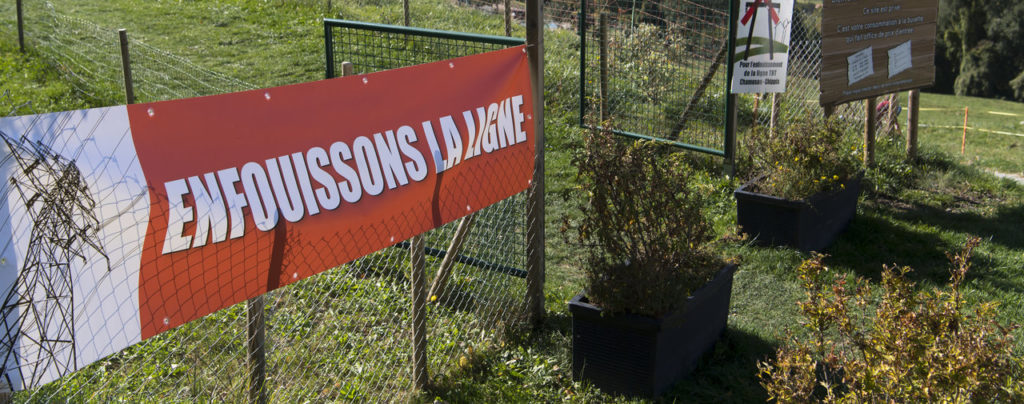An article published on November 11, 2018 in the newspaper Le Temps speaks about the new initiative of Robert Klapisch, the president of our foundation.
Robert Klapisch, a former research director at CERN, wants to demonstrate the viability of superconductivity as a means of energy transport. He plans to build an 18-kilometer test bed in Valais.
The very high voltage line (THT) that will link Chamoson to Chippis, in Valais, could be done without pylons. Robert Klapisch, the former director of research at CERN, is convinced of this. His solution to this: superconductivity. Discovered in 1911, this phenomenon, which is characterized by the absence of electrical resistance and the expulsion of the magnetic field, appears when certain materials are cooled to temperatures close to absolute zero (-273.15°C). This technique would make it easy to bury THT lines.
For years, opponents of the planned Valais electric highway have been calling for it to be buried. Defeated by the Federal Court in September 2017 on this issue, they achieved a small victory in early November. Studies will be carried out to investigate the possibility of moving five problem towers in the Grône and Chippis regions. This is a way of easing the conflict that has been going on for years between Swissgrid, the Swiss electricity company, and the opponents. A conflict that prompted Robert Klapisch to act.
A way forward
This Frenchman, who has lived in Valais for about twenty years, intends to demonstrate that there is an alternative to airlines to carry electricity. “People don’t live where energy is produced. His transport is necessary. But we have to find the most economical solutions,” insists the 85-year-old physicist. His goal is to persuade Swissgrid that superconductivity is the way forward.
In partnership with Pierre Weill, the founder of the Sofres survey institute, Bruno Lescoeur, former member of the Executive Committee of Electricité de France, and Jacques Lewiner, former scientific director of the Ecole supérieure de physique et de chemistry industrielle de la ville de Paris, Robert Klapisch created a company called Promosupra. The purpose of this study is to demonstrate the viability of superconductivity. “We’d like to do that in the next six months,” says the physicist. The first step is to raise the 30 million francs needed for the project.
An 18-kilometer test
This money will enable life-size tests to be carried out in Valais. Robert Klapisch imagines an 18-kilometer stretch to carry out these tests. The cable, with a diameter of about thirty centimeters, includes in particular the superconducting material, which will be cooled by liquid helium. It will be buried in a trench about one meter deep. “The environmental impact is minimal and much less than the current very high voltage lines, whether they are overhead or underground,” Klapisch insists.
To facilitate the exercise, the physicist hopes to be able to place his installation along the A9 motorway. He met in mid-October with Roberto Schmidt, the State Energy Advisor, to discuss this project. As the discussions are still ongoing and a second session has been scheduled for mid-December, the canton does not wish to discuss the subject at this time.
In order to persuade Swissgrid of the merits of his project, Robert Klapisch intends to demonstrate to the company responsible for operating the national electricity network that this solution is financially advantageous for it. “If superconducting wires are more expensive than copper cables, the overall balance is advantageous,” he argues. We have to take into account the avoided civil works and the cost of the towers saved.”
Millions for a few hundred meters
The projects carried out to date show the opposite. The 600-meter cable installed in New York City in 2008 to power 300,000 homes on Long Island cost some $60 million. The one-kilometer project integrated into the electricity grid of the city of Essen in Germany required an investment of EUR 13.5 million. These figures suggest that Robert Klapisch’s estimate of 30 million francs for an 18-kilometer cable is too low.
“The difference lies in the material used to create the superconducting wire,” says the physicist. So far, the tests have been carried out with high-temperature superconducting materials, which are of an earlier generation and very expensive.” Robert Klapisch is banking on magnesium dibromide (MgB2) for his project. “This much cheaper compound lends itself to forming extremely thin cables over several kilometers,” he says.
For the time being, Swissgrid has not heard of Robert Klapisch’s project and states that ‘no research on this subject is currently being carried out. The company adds that due to “the small footprint, superconductivity is particularly suitable for wiring in densely populated areas where there is little room for new lines, such as in cities.” While it recognizes the benefits of this technology, Swissgrid says it does not know whether it will be used in future projects.
To read the article on the Time website: The solution to wiping out power towers




